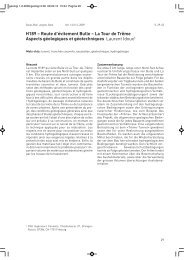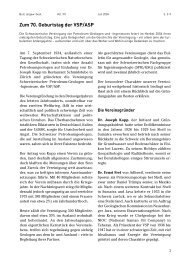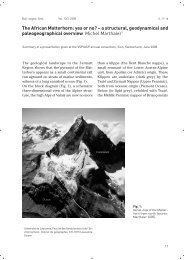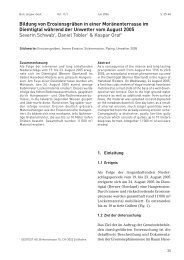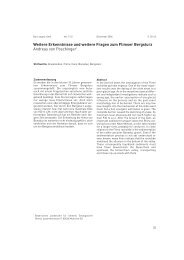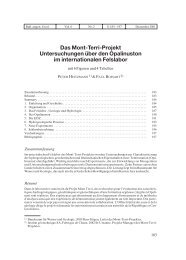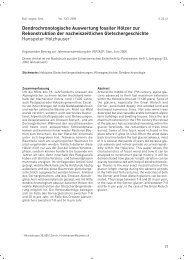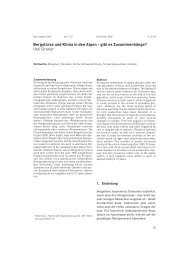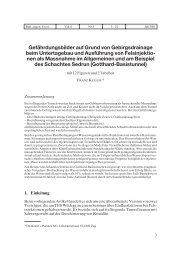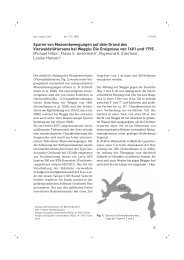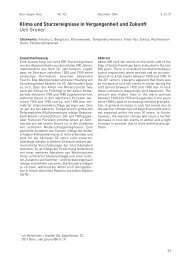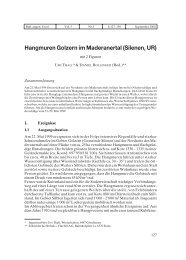The Alpine Molasse Basin
The Alpine Molasse Basin
The Alpine Molasse Basin
You also want an ePaper? Increase the reach of your titles
YUMPU automatically turns print PDFs into web optimized ePapers that Google loves.
Bull. angew. Geol. Vol. 10/1 Juli 2005 S. 75-86<br />
<strong>The</strong> <strong>Alpine</strong> <strong>Molasse</strong> <strong>Basin</strong> – Review of Petroleum Geology and<br />
Remaining Potential James Véron 1<br />
Keywords: <strong>Molasse</strong> <strong>Basin</strong>, Petroleum potential, Yet-to-Find, Austria, Germany<br />
Abstract<br />
Given the decades of exploration activities in the<br />
German and Austrian areas of the <strong>Molasse</strong> <strong>Basin</strong>,<br />
new large discoveries in the basin may be rare. However,<br />
technical progress, new seismic interpretation<br />
and geological models generated new prospects and<br />
increased exploration efficiency. <strong>The</strong> largest gas<br />
field in Upper Austria, was discovered in 1997 and<br />
several small to medium discoveries were found in<br />
the Austrian <strong>Molasse</strong> <strong>Basin</strong> since. <strong>The</strong> presented<br />
here Yet-to-Find analysis of the <strong>Molasse</strong> <strong>Basin</strong> indicates<br />
that up to several hundred (small to very<br />
small) fields can still be discovered, with the estimated<br />
total recoverable reserves exceeding 400<br />
MMboe (million barrels of oil equivalent).<br />
1 Introduction<br />
<strong>The</strong> <strong>Molasse</strong> <strong>Basin</strong> is located to the north of<br />
the Alps and extends from France to the eastern<br />
border of Austria (Fig. 1). In its present<br />
day configuration, the basin is about 900 km<br />
long and up to 120 km wide in the German<br />
sector. <strong>The</strong> <strong>Molasse</strong> <strong>Basin</strong> is a Cenozoic Foredeep<br />
<strong>Basin</strong>, the basin fill of which fundamentally<br />
responded to flexural subsidence. Its<br />
substratum comprises Mesozoic, locally Permo-Carboniferous<br />
and crystalline/metamorphic<br />
basement rocks.<br />
After decades of exploration – over 1’200<br />
exploratory wells have been documented –<br />
and with some 192 discoveries, the basin is<br />
considered mature in terms of hydrocarbon<br />
exploration. However, several oil and gas<br />
1 <strong>Basin</strong> Specialist, IHS Energy,<br />
24 Chemin de la Mairie, 1258 Perly-Geneva<br />
Zusammenfassung<br />
Die langjährigen Explorationstätigkeiten in den<br />
deutschen und österreichischen Teilen des <strong>Molasse</strong><br />
Beckens, lassen neue grosse Kohlenwasserstoff-Funde<br />
als eher unwahrscheinlich erscheinen.<br />
Neueste technologische Entwicklungen im Bereich<br />
der Seismik sowie neue geologische Modelle<br />
haben jedoch die Explorationserfolge erhöht. Das<br />
grösste Gasfeld Oberösterreichs wurde zum Beispiel<br />
im Jahre 1997 entdeckt. Mehrere andere neue<br />
Öl- und Gasfunde folgten danach. Die hier präsentierte<br />
«Yet-To-Find» Analyse des Beckens zeigt,<br />
dass einige hundert kleine Kohlenwasserstoff-Felder,<br />
mit einem geschätzten förderbaren Reservevolumen<br />
von über 400 MMboe (million barrels of oil<br />
equivalent), noch zu entdecken sind.<br />
companies are showing interest in the area<br />
as opportunities related to not yet fully<br />
explored specific plays might still exist in<br />
various types of prospects. For example, the<br />
latest discoveries in the basin, Zaggling and<br />
Strass were made by RAG (Rohöl-Aufsuchungs<br />
AG/Österreich) in 2004 in the<br />
southwestern corner of the Salzburg block,<br />
in Austria. Zaggling encountered gas in the<br />
Oligocene series, while Strass in the<br />
Miocene series.<br />
75
Fig. 1: <strong>Basin</strong> Location and Generalised Distribution Map of the Reservoirs in Germany and Austria.<br />
2 Regional Geology<br />
<strong>The</strong> <strong>Molasse</strong> <strong>Basin</strong> extends along the northern<br />
front of the <strong>Alpine</strong> Mountain Range of<br />
Central Europe. Trending WSW–ENE, it covers<br />
areas of France, Switzerland, Germany<br />
and Austria. Main areas of deposition are<br />
north-central Switzerland, southernmost<br />
Germany and eastern Austria.<br />
<strong>The</strong> <strong>Molasse</strong> <strong>Basin</strong> and its substratum underwent<br />
four major evolutionary stages, termed<br />
here as Syn-rift, Epicontinental, Passive Margin<br />
and <strong>Alpine</strong> Foredeep. During Permo-Carboniferous<br />
times (Syn-rift phase), narrow<br />
troughs formed along the dominating<br />
ENE–WSW and WNW–ESE trends of the<br />
Variscan wrench faults. In the <strong>Molasse</strong> <strong>Basin</strong><br />
area, those are the Giftthal, Bodensee and<br />
Entlebuch troughs. Epicontinental deposits<br />
of Triassic-Middle Jurassic age progressively<br />
overstep the Variscan Basement, or on Permo-Carboniferous<br />
series, from NW to SE<br />
(Boigk 1981), to the effect that neither the<br />
Landshut-Neuötting paleohigh of Eastern<br />
Bavaria nor major parts of the Austria<br />
<strong>Molasse</strong> <strong>Basin</strong> area are covered.<br />
<strong>The</strong> passive margin stage was accompanied<br />
by transpressional and transtensional movements<br />
in Middle Jurassic to Early Cretaceous<br />
time (Malkovsky 1987; Nachtmann & Wagner<br />
76<br />
1987). <strong>The</strong> shift from the epicontinental to<br />
the passive margin setting is being correlated<br />
with Jurassic extensional events (Roeder<br />
& Bachmann 1996), apparently falling into<br />
the time of Middle Jurassic crustal separation<br />
in the western Tethys (Ziegler 1982).<br />
<strong>The</strong> Late Cretaceous to Paleogene was dominated<br />
by primarily strike-slip movements<br />
along NW–SE directions.<br />
Deposition was resumed at basin-wide scale<br />
during the Paleogene, reflecting the flexural<br />
basin development in response to Africa-<br />
Europe convergence and subduction of the<br />
European Plate. Sediments were mainly<br />
sourced from the south, onlapping progressively<br />
to northwest and, in terms of facies<br />
evolution, changed from marine, turbidite<br />
sedimentation to non-marine, freshwater<br />
clastics. As a result of the flexural bending of<br />
the crust, mainly extensional stress was<br />
induced in an overall compressional setting,<br />
causing the formation of sets of synthetic<br />
and antithetic normal faults which trend<br />
mainly parallel to the basin axis.<br />
Two geologically and geomorphologically<br />
differing entities are observed within the<br />
basin: the mainly undeformed part (Unfolded<br />
<strong>Molasse</strong>) which makes up more than 90%
of the basin, and the deformed part, the Folded<br />
and thrusted (subalpine) <strong>Molasse</strong>, which<br />
takes up the southernmost parts of the basin<br />
area, being limited to the south by different<br />
tectonic units of the <strong>Alpine</strong> mountain range.<br />
Locally, particularly in the Upper Austria<br />
area, the fold belt is absent, overridden by<br />
the southerly <strong>Alpine</strong> thrusts. <strong>The</strong> division of<br />
the <strong>Molasse</strong> <strong>Basin</strong> into deformed and undeformed<br />
sub-units dates back to times of field<br />
geological work, when the limit between the<br />
two domains was drawn along the northernmost<br />
thrust fault with surface expression,<br />
lacking seismic control. This definition is<br />
maintained here, although recent reviews of<br />
subsurface data indicated the presence of a<br />
frontal triangular zone at regional scale,<br />
separating both entities.<br />
<strong>The</strong> <strong>Alpine</strong> <strong>Molasse</strong> <strong>Basin</strong> (Fig. 1) is limited<br />
along the northern margin, mainly on Swiss<br />
terranes, by the mountain range of the Jura<br />
Fold Belt. Along the transition from the<br />
<strong>Molasse</strong> lowlands to the Jura Mountains, the<br />
<strong>Molasse</strong> sediments – although unconformably<br />
resting on their substratum – depict<br />
the structuration, i.e. folding and faulting, of<br />
the Jura Fold Belt. This reflects the young<br />
(Late Miocene to Pliocene) age of the fold belt<br />
deformation. <strong>The</strong> Mesozoic platform area of<br />
the Swabian and Franconian Jura adjoins to<br />
the northeast, where youngest <strong>Molasse</strong> sediments<br />
onlap on that platform. <strong>The</strong> onlap sediments<br />
are partially eroded, indicating an<br />
original basin outline further north.<br />
Along the northeastern border, in East Bavarian<br />
and Upper Austrian territories, the<br />
Bohemian Massif borders the basin along<br />
faults. Locally, the faults are covered by<br />
uppermost <strong>Molasse</strong> sediments onlapping the<br />
massif's tilted southern spur. Away from the<br />
St. Poelten area, a fundamental change in<br />
direction takes place, and the limit follows a<br />
SW–NE direction, along a major fault. This<br />
Neogene fault is locally buried under the<br />
overlying <strong>Molasse</strong> sediments. In the east,<br />
transition from the adjoining Vienna <strong>Basin</strong> in<br />
part is fault controlled and in part follows the<br />
onlap pattern of the Vienna <strong>Basin</strong> on the<br />
Waschberg Zone, the eastern equivalent of<br />
the Folded <strong>Molasse</strong>.<br />
To the south, the <strong>Molasse</strong> <strong>Basin</strong> terminates<br />
along the various thrust fronts which delimit<br />
the <strong>Alpine</strong> system.<br />
3 Petroleum Geology<br />
3.1 Petroleum Systems<br />
Four petroleum systems are believed controlling<br />
the occurrence of hydrocarbons in<br />
the basin (Fig. 2). However, due to the<br />
absence of unequivocal evidence, i.e. supportive<br />
oil/gas – source correlations, an element<br />
of uncertainty is inherent in the identification<br />
of the petroleum systems.<br />
1) <strong>The</strong> Permo/Carboniferous - Triassic/<br />
Jurassic/Neogene Petroleum System<br />
Upper Carboniferous and Lower Permian<br />
(Rotliegend) coal seams and bituminous<br />
shales provide the source rocks. <strong>The</strong> petroleum<br />
system, as the distribution of source<br />
rocks, is confined to narrow rift grabens.<br />
Traps of those locally confined areas are<br />
antithetic, tilted fault blocks (particularly in<br />
the German Western <strong>Molasse</strong> area), and<br />
thrust sheets or subthrust fault blocks in the<br />
Folded <strong>Molasse</strong> area, as is the case of the<br />
Entlebuch discovery. Trap formation essentially<br />
took place at Oligocene to Mid Miocene<br />
times as far as the unfolded <strong>Molasse</strong> is concerned,<br />
and within the period Late Eocene to<br />
Late Miocene in the Folded <strong>Molasse</strong> areas.<br />
Reservoirs range, within the Mesozoic, from<br />
Keuper and Lower/Mid Jurassic sandstones<br />
to Muschelkalk and Upper Jurassic carbonates<br />
and, at Neogene level, to the Chattian<br />
Baustein Beds, mainly.<br />
Seals are mainly provided for by intraformational<br />
shales. Evaporites partly seal Triassic<br />
reservoirs. Shales and partly marls of Early<br />
Tertiary age provide seal for both Lower Tertiary<br />
and truncated Upper Jurassic reservoirs.<br />
77
2) <strong>The</strong> Posidonia Shale - Cretaceous/<br />
Neogene Petroleum System<br />
Being controlled by both facies changes and<br />
erosional effects, the source rocks show<br />
almost complementary distribution patterns:<br />
the Posidonia Shale predominate in<br />
the northern sector, the Upper Jurassic<br />
source rocks in the southern sector.<br />
Traps are provided for by antithetic, tilted<br />
fault blocks in the areas of the Unfolded<br />
<strong>Molasse</strong> and by subthrust fault blocks and<br />
particularly thrust sheets, as is the case in<br />
the Waschberg Zone of Lower Austria in the<br />
Folded <strong>Molasse</strong>. Trap formation essentially<br />
took place at Oligocene to Mid Miocene<br />
times as far as the Unfolded <strong>Molasse</strong> areas is<br />
concerned, and within the period Late<br />
Eocene to Late Miocene in the Folded<br />
<strong>Molasse</strong> areas.<br />
3) <strong>The</strong> Lattorfian Fish Shale -<br />
Cretaceous/Neogene Petroleum System<br />
It is predominantly an oil system and is<br />
responsible for the oil accumulations located<br />
within – and next to – the distribution area<br />
of mature Sannoisian source rocks, which are<br />
fish shales.<br />
Traps are provided for by antithetic, tilted<br />
fault blocks in the areas of the Unfolded<br />
<strong>Molasse</strong> and by subthrust fault blocks and<br />
thrust sheets, as in the Waschberg Zone of<br />
the Lower Austria Folded <strong>Molasse</strong>. Trap formation<br />
took place at Oligocene to Mid<br />
Miocene times as far as the Unfolded<br />
<strong>Molasse</strong> areas is concerned, and within the<br />
period Late Eocene to Late Miocene in the<br />
Folded <strong>Molasse</strong> areas.<br />
Reservoir rocks of this system are those<br />
aligned along migration paths with updip<br />
migration from deeper basin parts, being<br />
controlled by buoyancy and differential pressure.<br />
<strong>The</strong> range of oil reservoirs is therefore<br />
from Upper Austria's Dogger sandstone and<br />
carbonate and Cenomanian sandstone reservoirs<br />
to Upper Eocene sandstones and<br />
Oligocene carbonates and sandstones. Seal<br />
78<br />
is mainly provided for by intraformational<br />
shales. In the case of the Dogger reservoirs,<br />
tight Upper Jurassic carbonates may act as<br />
additional seal, and in the case of the Campanian<br />
reservoir, being potentially truncated,<br />
Lower Tertiary shales may serve as additional<br />
seal.<br />
<strong>The</strong> petroleum system is restricted to the<br />
areas of the Austrian and German Eastern<br />
<strong>Molasse</strong> and of parts of the German Western<br />
<strong>Molasse</strong>.<br />
4) <strong>The</strong> Oligocene - Oligocene/Lower<br />
Miocene Petroleum System<br />
Source rocks are of the Oligocene age and<br />
were identified on a basis of gas isotope<br />
analyses (Schoell 1984), demonstrating that<br />
part of the gas, particularly in Upper Austrian<br />
and German Western <strong>Molasse</strong>, is of biogenic<br />
origin. Reservoirs in the petroleum system<br />
are sandstones of Rupelian, Chattian,<br />
Aquitanian and Burdigalian age, as evidenced<br />
in the productive areas. Seals are<br />
provided for by intraformational Oligocene<br />
and Miocene shales. Gas generation is suggested<br />
having taken place from Middle<br />
Oligocene times onwards, and will be an<br />
ongoing process. Expulsion and migration<br />
obviously follow the same pattern, with<br />
respective retardation. Traps are antithetic<br />
fault blocks and stratigraphic traps, particularly<br />
sealed off bodies of channel sands. Trap<br />
formation was at Oligocene to Middle<br />
Miocene time, following deposition of postreservoir<br />
intra-formational shale seals.<br />
3.2 Source rocks<br />
Primary source rocks for oil in the basin (Fig.<br />
2) are considered to be the Oligocene marine<br />
fish shales (Lattorfian Fish Shale) and the<br />
Lower Jurassic (Toarcian) marine Posidonia<br />
Shale. <strong>The</strong> Upper Jurassic Quinten Limestone<br />
of the western areas of the basin and<br />
the Upper Jurassic bituminous marls of the<br />
eastern areas, both representing Tethys<br />
facies, are secondary oil source rocks. Upper
Carboniferous (Stephanian) and Lower Rotliegend<br />
(Autunian) coal seams and lacustrine<br />
shales may have yielded both gas and<br />
oil.<br />
Gas that was identified in the gas reservoirs<br />
of the Eastern <strong>Molasse</strong> (e.g. Ampfing, Bierwang<br />
discoveries in Germany) and of the<br />
Upper Austrian <strong>Molasse</strong> (e.g. Diethaming 1A,<br />
Treubach field/discovery) is suggested having<br />
been generated mainly from Mid/Upper<br />
Oligocene (Rupelian/Chattian) and basal Miocene<br />
(Chattian/Aquitanian) marine shales.<br />
Since the primary source rocks lack oil maturity<br />
next to the sites of the oil bearing reservoirs,<br />
it is therefore expected that oil (and<br />
gas) generation took place at greater depths,<br />
beneath the thrust belt (Gier 2000), thus<br />
involving lateral and updip migration.<br />
3.3 Reservoirs<br />
Productive reservoirs are present both at<br />
Mesozoic levels (54 MMboe – million barrels<br />
of oil equivalent – of recoverable reserves to<br />
date) and within the Tertiary <strong>Molasse</strong> section<br />
(483.3 MMboe; Fig. 2). Triassic reservoirs<br />
include: the Muschelkalk Trigonodus<br />
Dolomite, deposited along the basin rim, the<br />
Keuper nearshore shallow marine Kiesel<br />
(Chert) Sandstone, the lacustrine Stuben<br />
Sandstone and the littoral/deltaic Rhaetian<br />
Sandstone. <strong>The</strong> Jurassic shallow marine platform<br />
settings host the Lias-alpha and Dogger-beta<br />
sandstones, representing local bar<br />
sands, and Upper Jurassic reefal and fractured<br />
carbonates. Within the Cretaceous section,<br />
shallow marine glauconitic sandstones<br />
form the main reservoirs, i.e. the Aptian and<br />
Albian Greensand units, Cenomanian and<br />
Turonian glauconite sandstones and the<br />
Upper Campanian sandstone. <strong>The</strong>y form<br />
important reservoirs of the Austrian<br />
<strong>Molasse</strong>, also in terms of reservoiring hydrocarbon<br />
volumes, holding some 13 Bscfg (Billion<br />
standard cubic feet of gas) in both the<br />
Voitsdorf and Schwanenstadt fields.<br />
Reservoirs of the Tertiary <strong>Molasse</strong> are contained<br />
in both megasequences: the Upper<br />
Marine <strong>Molasse</strong> and Lower Marine <strong>Molasse</strong>.<br />
<strong>The</strong> Upper Eocene reservoirs are: the Basal<br />
Sandstone, Ampfing Sandstone and Lithothamnia<br />
Limestone. <strong>The</strong>y were the early targets<br />
of exploration in both Germany and Austria,<br />
and offer detailed analyses of the reservoir<br />
characteristics, facies variations and<br />
distribution patterns. <strong>The</strong>y all, together with<br />
the Isen Sandstone, represent shallow<br />
marine platform conditions.<br />
In the German Haag field (5.5 Bscfg), the Isen<br />
Sandstone Formation reservoir is 4 m thick<br />
in average but shows an average porosity of<br />
20% and permeability values of up to 200 mD<br />
(Milli-Darcy). <strong>The</strong> Lithothamnia Limestone<br />
reservoir (3.68 Bscfg) is much thicker (averaging<br />
48 m) and has porosity values reaching<br />
30% and permeability values of 10 mD in<br />
average.<br />
Within the Lower Marine <strong>Molasse</strong> (Late<br />
Oligocene (Chattian) to Early Miocene (Aquitanian)<br />
reservoirs represent the entire range<br />
of marine environments. From west (Bavaria)<br />
to east (Upper Austria) these are: the<br />
marine-brackish Baustein Sandstone, the<br />
deltaic channel-deposition of the Chatt and<br />
Aquitan sandstones and the turbiditic<br />
Puchkirchen sandstone series (Robinson &<br />
Zimmer 1989). <strong>The</strong> Upper Marine <strong>Molasse</strong><br />
contains two reservoir levels: the Burdigalian<br />
basal, transgressive marine Gendorf<br />
Sandstone in the west (Bavaria) and its eastern<br />
(Upper Austria) equivalent, the Hall Formation.<br />
<strong>The</strong> basal Hall Formation and the underlying<br />
Upper Puchkirchen Formation are important<br />
reservoirs in several Austrian fields, including<br />
Puchkirchen (100 Bscfg) and Atzbach<br />
(120 Bscfg).<br />
<strong>The</strong> Puchkirchen field, located approximately<br />
4 km SW of the Atzbach gas field, was the<br />
first commercial oil field discovered in the<br />
Austrian <strong>Molasse</strong> <strong>Basin</strong> (Upper Eocene sandstone).<br />
However, the field became a gas and<br />
oil field after the discovery of the new nonassociated<br />
gas horizons in 1969 and 1972<br />
(Upper Puchkirchen and Hall formations).<br />
By contrast, the Freshwater <strong>Molasse</strong> series<br />
79
Fig. 2: Generalised Stratigraphic Chart of the <strong>Molasse</strong> <strong>Basin</strong> and its substratum.<br />
Compiled after works from Boigk (1981), Kraus (1969), Bachmann & Muller (1991), Ziegler (1990),<br />
Aigner & Bachmann (1992), Bachmayer (1980), Malzer (1981), Kolmann (1977), Wessely (1988).<br />
80
Legend<br />
81
are almost devoid of productive reservoirs in<br />
the upper sequence, or the sandstone reservoirs<br />
are insignificant (lower sequence).<br />
Noteworthy, this does not strictly apply to<br />
the transition zone, i.e. the brackish freshwater<br />
environment. <strong>The</strong> Oncophora Beds of<br />
Lower and Upper Austria (considered for<br />
some time as part of the Upper Marine<br />
<strong>Molasse</strong>) are hydrocarbon bearing in a number<br />
of fields (Wildendurnbach, Roseldorf and<br />
Alt Prerau). In the Wildendurnbach field (60<br />
Bscfg), the Oncophora Beds are up to 110 m<br />
thick (averaging 51 m), show porosity values<br />
of 13 to 33.8% and permeability values reaching<br />
3000 mD (average 30 mD).<br />
3.4 Seals<br />
<strong>The</strong> Oligocene fish shales are the principal<br />
seal formation of the basin. <strong>The</strong>y cap both<br />
the various base Tertiary reservoirs and, ultimately,<br />
the Mesozoic reservoirs subcropping<br />
below the Tertiary section. <strong>The</strong> conspicuous<br />
gas-bearing Middle Tertiary section owes its<br />
prospectivity to the presence of intraformational<br />
shales. Intraformational seals, if not<br />
locally replaced by evaporites, also form the<br />
seals of the Mesozoic reservoirs, exemplified<br />
by the Early Jurassic shales which act as seal<br />
to the Rhaetian/Lias-alpha sandstone reservoirs.<br />
<strong>The</strong> Mesozoic-age evaporites seem<br />
insignificant as seals.<br />
4 Discussion<br />
4.1 Remaining Prospects<br />
Technical progress together with a better<br />
understanding of the geology of the area<br />
increased exploration efficiency in recent<br />
years. Application of the concepts of<br />
sequence stratigraphy and seismic stratigraphy<br />
yielded new prospects within the basin<br />
and opened potential for testing previously<br />
undeveloped plays. Such may be the case of<br />
the stratigraphic traps within the Mid-Tertiary<br />
turbiditic successions in the German<br />
82<br />
Eastern <strong>Molasse</strong> and Upper Austrian<br />
<strong>Molasse</strong>, though the concept requires refining<br />
by additional 3D seismic acquisitions.<br />
Sparked by introduction of the new geological<br />
models, a new exploration phase started<br />
in the late 1990s with a new major discovery,<br />
Haidach, in 1997 (the largest gas field in<br />
Upper Austria; 150 Bscfg of recoverable<br />
reserves). Since then, several small to medium<br />
size discoveries were made in the Austrian<br />
part of the basin, including Nussdorf West<br />
in 2000 (100 Bscfg).<br />
Re-interpretation of the tectonically complex<br />
«triangle zone» in the Bavarian part of the<br />
basin, led to a surge of exploration interest.<br />
<strong>The</strong> «triangle zone play» is proposed within<br />
the duplex structure along the main <strong>Alpine</strong><br />
thrust, with potential reservoirs in the Tertiary<br />
section. If positively tested the play<br />
may lead to the recognition of further similar<br />
prospects (though well-developed triangle<br />
zones in the basin seem more an exception<br />
than a rule). Additionally, the geometry of<br />
the zone changes along strike – the level of<br />
basal detachment horizon is critical for<br />
stacking of the reservoirs (i.e. Baustein Beds<br />
in Bavaria).<br />
Other exploration possibilities include<br />
prospects in the sub-thrust positions, as well<br />
as prospects related to the Permo-Carboniferous<br />
grabens.<br />
4.2 Yet-to-Find<br />
<strong>The</strong> Yet-to-Find (YTF) tool attempts to provide<br />
an estimate and the distribution of<br />
remaining recoverable reserves for a specific<br />
basin. A principal empirical feature of the<br />
hydrocarbon distribution applied here is<br />
that, in a given basin, there are usually a few<br />
large fields and a great number of small ones.<br />
<strong>The</strong> assumption is that the biggest structures<br />
are drilled in the initial phase of exploration<br />
and, hence, the biggest discoveries are made<br />
first, with the smaller fields being found during<br />
the later exploration phases (the fields<br />
are discovered in order of declining size).<br />
We construct a graphical representation of
the basin history (Fig. 3) by plotting sizes of<br />
the discoveries as a frequency function. <strong>The</strong><br />
largest field is ranked 1 (one very large field),<br />
the second largest field(s) rank 2, with the<br />
smaller size fields (ranks) showing increasing<br />
frequency of occurrence. In the subsequent<br />
YTF graph (Fig. 4), the field sizes are<br />
plotted on the Y-axis for each rank on the Xaxis<br />
(for comparison, reserves are shown in<br />
MMboe on a logarithmic scale). It has been<br />
observed that a plot of log field size against<br />
log of rank approximates to a straight line.<br />
One can envisage that in a fully exploited<br />
basin in which all field sizes are represented<br />
and have been discovered, the fields frequency<br />
graph would follow a straight line<br />
(we recognise that this pattern may not hold<br />
true for exploration in e.g. deep-water areas).<br />
Analyses of various basins showed that, in a<br />
partially exploited basin, the absence of<br />
medium and small field sizes results in a<br />
marked drop at the right part of the field frequency<br />
curve. In the areas where it is<br />
believed that the major discoveries have<br />
been made, such as in the <strong>Molasse</strong> <strong>Basin</strong>, the<br />
slope of the line can be estimated by the<br />
presence of large-size discoveries, to create a<br />
synthetic distribution of the Estimated Total<br />
Reserves (ETR), indicating the yet be made<br />
discoveries. <strong>The</strong> size of these discoveries is<br />
then calculated by subtracting the Reserves<br />
to Date (RTD) from ETR. By generating such<br />
curve, we aim at validating the success<br />
ration against the remaining potential of the<br />
basin.<br />
By plotting known sizes of discoveries versus<br />
the number of discoveries in a basin, we<br />
obtain a field size distribution graph (Fig. 5).<br />
Also based on the assumption that reserves<br />
are lognormally distributed in nature, a<br />
Fig. 3: Creaming Curve by Time Graph<br />
<strong>The</strong> creaming curve displays cumulative reserves versus discovery date in a basin or area. <strong>The</strong> cumulative<br />
reserves are plotted in MMboe for comparison.<br />
83
Fig. 4: Yet to Find Graph<br />
<strong>The</strong> Yet to Find Graph is a line graph containing two series of data, the actual reserves (RTD) and the<br />
estimated reserves (ETR). <strong>The</strong> Y-Axis shows the Field Size in MMboe (lognormal scale). <strong>The</strong> X-Axis<br />
shows the Rank (lognormal scale) of Fields for each size.<br />
Fig. 5: Original Oil & Gas Field Size<br />
Field size distribution graphs display the number of fields (Y-Axis) per reserves size category (X-Axis,<br />
semi-logarithmic scale). Reserves are displayed in million barrels oil equivalent (MMboe) for comparison.<br />
84
mature field size distribution would show a<br />
logarithmically increasing number of fields<br />
with decreasing reserves size. <strong>The</strong> gaps<br />
between the actual number of fields and the<br />
mature field size distribution curve indicate<br />
the «missing fields».<br />
In the here presented YTF analysis of the<br />
<strong>Molasse</strong> <strong>Basin</strong>, we tested separately reservoirs<br />
of the Mesozoic and Tertiary age with<br />
recoverable reserves exceeding 2 MMboe.<br />
Accordingly, yet-to-find reserves are estimated<br />
at 55 MMboe and 400 MMboe for the given<br />
geological interval. <strong>The</strong> analyses indicate<br />
also that only small to very small hydrocarbon<br />
accumulations remain to be discovered<br />
in the basin, with a few discoveries possible<br />
in the Mesozoic series and a few dozen small<br />
discoveries (5–10 MMboe) remaining within<br />
the Tertiary successions.<br />
5 Conclusion<br />
Despite the large number of fields discovered<br />
in the <strong>Molasse</strong> <strong>Basin</strong> areas of Austria<br />
and Germany, i.e. in the areas of prime<br />
prospectivity, and despite the decades of<br />
exploration activities, the basin is believed<br />
to still hold undiscovered accumulations of<br />
economical sizes.<br />
Our empirical yet to find analyses show that<br />
it is highly unlikely that large discoveries will<br />
be found, but small discoveries within the<br />
Tertiary series may be expected in the ensuing<br />
years. It is possible that the basin’s close<br />
proximity to the consumers will further<br />
attract exploration from the domestic companies<br />
that can make small-size discoveries<br />
economic.<br />
Acknowledgments<br />
<strong>The</strong> Author would like to thank IHS Energy Inc. for<br />
allowing the time and resources to make this article<br />
possible. Further credit and appreciation is<br />
extended to Piotr Gawenda for his comments on<br />
the earlier version of the manuscript. Thanks are<br />
also extended to Didier Arbouille and Dimitri Massaras<br />
for the support and review of this article.<br />
For further information regarding this article and<br />
similar basin studies please contact James Véron<br />
(james.veron@ihsenergy.com) or Didier Arbouille<br />
(didier.arbouille@ihsenergy.com).<br />
References<br />
Aigner, T. & Bachmann, G.H. 1992: Sequence-stratigraphic<br />
framework of the German Triassic.<br />
Sedimentary. Geology, 80. Elsevier Science<br />
Publishers, Amsterdam, Netherlands, 115–135.<br />
Bachmann, G.H. & Mueller, M. 1991: <strong>The</strong> <strong>Molasse</strong><br />
<strong>Basin</strong>, Germany : evolution of a classic petroliferous<br />
foreland basin. In: Spencer, A.M. (ed), Generation,<br />
Accumulation and Production of Europe's<br />
Hydrocarbons, European Association of Petroleum<br />
Geoscientists Special Publication, 1. Oxford<br />
University Press, New York, United States,<br />
263–276<br />
Bachmayer, F. 1980: Erdöl und Erdgas in Oesterreich<br />
(Oil and Gas in Austria). Naturhistorisches<br />
Museum. Wien und F. Berger, Horn, Wien, Austria.<br />
Boigk, H. 1981: Erdöl und Erdölgas in der Bundesrepublik<br />
Deutschland (Petroleum and natural<br />
gas in West Germany). Ferdinand Enke Publishers,<br />
Stuttgart, Federal Republic of Germany.<br />
Gier, S. 2000: Clay mineral and organic diagenesis<br />
of the lower Oligocene Schoeneck Fishshale,<br />
western Austrian <strong>Molasse</strong> <strong>Basin</strong>. Clay Minerals,<br />
35 (4). Mineralogical Society, London, United<br />
Kingdom, 709–717.<br />
Kollmann, K. 1977: Die Öl- und Gasexploration der<br />
<strong>Molasse</strong>zone Oberösterreichs und Salzburgs aus<br />
regionalgeologischer Sicht. Erdöl Erdgas Zeitschrift<br />
International Edition (Oil and Gas European<br />
Magazine), 93 (9). Urban-Verlag, Hamburg-<br />
Vienna, Federal Republic of Germany, 36–49.<br />
Kraus, L. 1969: Erdoel- und Erdgaslagerstaetten<br />
im ostbayerischen <strong>Molasse</strong>becken. Erdoel Erdgas<br />
Zeitschrift International Edition (Oil and Gas<br />
European Magazine), 11. Urban-Verlag, Hamburg-Vienna,<br />
Federal Republic of Germany,<br />
442–454.<br />
Malkovsky, M. 1987: <strong>The</strong> Mesozoic and Tertiary<br />
basins of the Bohemian Massif and their evolution.<br />
In: Ziegler, A. (ed), Compressional Intra Plate<br />
Deformations in the <strong>Alpine</strong> Foreland, Tectonophysics,<br />
137 (1–4). Elsevier, Amsterdam, Netherlands,<br />
31–42.<br />
85
Malzer, O. 1981: Geologische Charakteristik der<br />
wichtigsten Erdöl und Erdgastraeger der oberösterreichischen<br />
<strong>Molasse</strong> – Teil : II : Die Konglomerate<br />
und Sandsteine Oligozaens (Geological<br />
characteristic of the main oil and gas producing<br />
formations of the Upper Austrian <strong>Molasse</strong> <strong>Basin</strong><br />
– Part 2 : the conglomerates and sandstones of<br />
the Oligocene). Erdöl Erdgas Zeitschrift International<br />
Edition (Oil and Gas European Magazine),<br />
97 (1). Urban-Verlag, Hamburg-Vienna, Federal<br />
Republic of Germany, 20–28.<br />
Nachtmann, W. & Wagner, L. 1987: Mesozoic and<br />
Early Tertiary evolution of the <strong>Alpine</strong> Foreland in<br />
Upper Austria and Slazburg, Austria. In: Ziegler,<br />
A. (ed): Compressional Intra Plate Deformations<br />
in the <strong>Alpine</strong> Foreland, Tectonophysics, 137 (1–4).<br />
Elsevier, Amsterdam, Netherlands, 61–76.<br />
Robinson, D. & Zimmer, W. 1989: Seismic stratigraphy<br />
of Late Oligocene Puchkirchen Formation<br />
of Upper Austria. Geologic Modeling; Aspects of<br />
Integrated <strong>Basin</strong> Analysis and Numerical Simulation,<br />
Geologische Rundschau, 78 (1). Springer<br />
International, Berlin, Federal Republic of Germany,<br />
49–79.<br />
Roeder, D. & Bachmann, G.H. 1996: Evolution,<br />
structure and petroleum geology of the German<br />
<strong>Molasse</strong> <strong>Basin</strong>. In: Ziegler, P. & Horvath, F. (ed):<br />
Peri-Tethys Memoir 2: Structure and Prospects<br />
of <strong>Alpine</strong> <strong>Basin</strong>s and Forelands, Memoires<br />
Museum National d'Histoire Naturelle, 170. Editions<br />
du Museum National d'Histoire Naturelle,<br />
Paris, France, 263–284.<br />
Schoell, M. 1984: Wasserstoff- und Kohlenstoffisotope<br />
in organischen Substanzen, Erdölen und<br />
Erdgasen (Hydrogen and carbon isotopes in<br />
organic materials, petroleum and natural gas).<br />
Geologisches Jahrbuch, Reihe D: Mineralogie,<br />
Petrographie, Geochemie, Lagerstaettenkunde,<br />
67. Schweizerbart in Komm., Stuttgart, Federal<br />
Republic of Germany.<br />
Wessely, G. 1988: Der Tiefenaufschluss im Wiener<br />
Becken und der <strong>Molasse</strong>zone als Ausgangspunkt<br />
fuer die Alpenexploration in Oesterreich (Deep<br />
exploration in the Vienna <strong>Basin</strong> and in the <strong>Molasse</strong><br />
zone – impulse for <strong>Alpine</strong> exploration in Austria).<br />
Erdöl Erdgas Kohle (Oil and Gas Magazine),<br />
104 (11). Urban-Verlag, Hamburg-Vienna, Federal<br />
Republic of Germany, 440–446.<br />
Ziegler, P.A. 1982: Geological Atlas of Western and<br />
Central Europe. Elsevier Science Publishers,<br />
Amsterdam, Netherlands, 1–130.<br />
Ziegler, P.A. 1990: Geological Atlas of Western and<br />
Central Europe. 2nd Edition. Shell International<br />
Petroleum Maatschappij B.V.<br />
86



